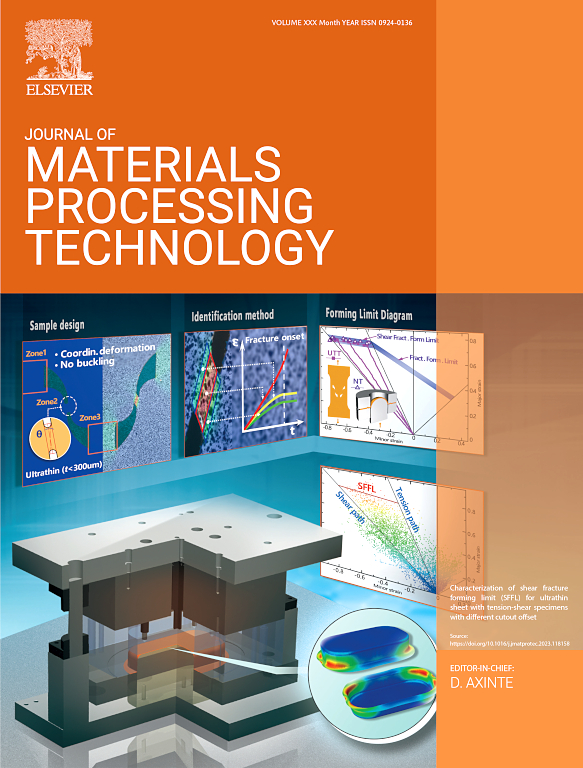Enhanced mechanical properties of TiAl alloy through Nb alloying by Triple-wire arc directed energy deposition
IF 6.7
2区 材料科学
Q1 ENGINEERING, INDUSTRIAL
Journal of Materials Processing Technology
Pub Date : 2025-03-13
DOI:10.1016/j.jmatprotec.2025.118800
引用次数: 0
Abstract
The introduction of alloying elements is an effective strategy to enhance the performance of titanium aluminides (TiAl). Wire arc directed energy deposition (DED) has cost advantages and high deposition rate, making it an emerging technology for fabricating TiAl alloys with promising application prospects. However, the efficient and flexible introduction of alloy elements for wire arc DED fabricated TiAl alloys is a key concern. In the present research, niobium (Nb) was selected as the alloying element, pure Ti, Al, and Nb wires were used as raw materials to introduce Nb into TiAl alloy via in-situ alloying using Triple-wire arc DED. This approach successfully fabricated the high Nb TiAl alloy Ti-45Al-8Nb and the feasibility of this method was confirmed. By comparing the phase composition, microstructure, and mechanical properties of Nb-containing Ti45Al8Nb and Nb-free Ti45Al fabricated by wire arc DED, the influence of Nb on the microstructure and strengthening mechanisms of TiAl alloys was revealed. The results indicate that Nb alloying significantly reduces internal defects, promotes the formation of the B2 phase, increases the content of γ phase and lamellar spacing, and refines the lamellar colonies. The solid solution strengthening, grain refinement strengthening, and dislocation strengthening effects induced by Nb alloying substantially enhanced the tensile strength and elongation of the TiAl alloy. The process for fabricating ternary TiAl alloys via wire arc DED proposed in this study utilizes three pure metal wires as raw materials without relying on the expensive and difficult-to-obtain pre-alloyed materials required in traditional processes. This approach demonstrates the capability of wire arc DED in fabricating multi-component TiAl alloys with controllable compositions.
三线电弧定向能沉积Nb合金提高TiAl合金的力学性能
合金元素的引入是提高钛铝化物(TiAl)性能的有效策略。电弧定向能沉积技术(DED)具有成本优势和沉积速度快,是一种新兴的TiAl合金制备技术,具有广阔的应用前景。然而,有效和灵活地引入合金元素的线弧DED制备TiAl合金是一个关键问题。本研究以铌(Nb)为合金元素,以纯Ti、Al、Nb丝为原料,采用三线弧DED原位合金化,将Nb引入TiAl合金中。该方法成功制备了高Nb TiAl合金Ti-45Al-8Nb,验证了该方法的可行性。通过比较含铌Ti45Al8Nb和无铌Ti45Al的相组成、显微组织和力学性能,揭示了铌对TiAl合金显微组织的影响及其强化机理。结果表明:Nb合金化显著减少了内部缺陷,促进了B2相的形成,增加了γ相含量和片层间距,细化了片层集落;Nb合金引起的固溶强化、晶粒细化强化和位错强化效应显著提高了TiAl合金的抗拉强度和伸长率。本研究提出的通过丝弧DED制备三元TiAl合金的工艺采用三根纯金属丝作为原料,而不依赖传统工艺所需的昂贵且难以获得的预合金材料。这种方法证明了电弧DED在制备成分可控的多组分TiAl合金方面的能力。
本文章由计算机程序翻译,如有差异,请以英文原文为准。
求助全文
约1分钟内获得全文
求助全文
来源期刊

Journal of Materials Processing Technology
工程技术-材料科学:综合
CiteScore
12.60
自引率
4.80%
发文量
403
审稿时长
29 days
期刊介绍:
The Journal of Materials Processing Technology covers the processing techniques used in manufacturing components from metals and other materials. The journal aims to publish full research papers of original, significant and rigorous work and so to contribute to increased production efficiency and improved component performance.
Areas of interest to the journal include:
• Casting, forming and machining
• Additive processing and joining technologies
• The evolution of material properties under the specific conditions met in manufacturing processes
• Surface engineering when it relates specifically to a manufacturing process
• Design and behavior of equipment and tools.
 求助内容:
求助内容: 应助结果提醒方式:
应助结果提醒方式:


